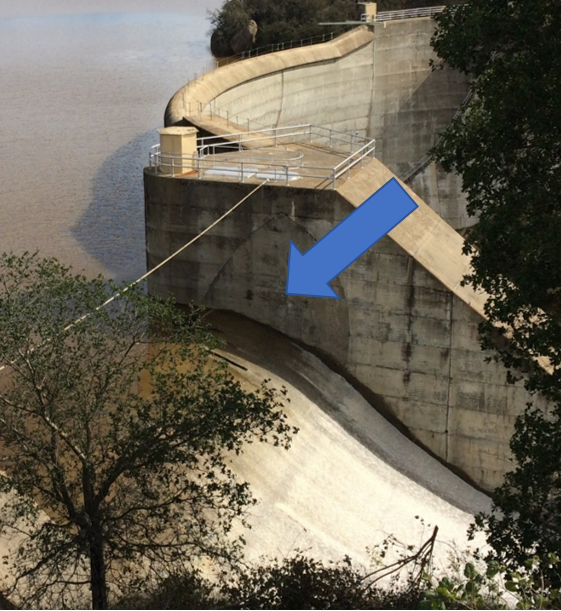Salinas Dam Disposition Study
Salinas Dam (forming Santa Margarita Lake) was built in 1941 under a military directive to supply water to Camp San Luis Obispo to support training needs for the Army during World War II. Due to this, the dam does not have a Civil Works Authority nor is it authorized for any flood risk management purposes. Shortly after it was built, Camp San Luis Obispo was no longer an active military facility, and the military transferred ownership to the Army Corps of Engineers (USACE) in 1955. USACE subsequently leased the facility to the San Luis Obispo County Flood Control and Water Conservation District (District) to operate the dam to provide water supply for the City of San Luis Obispo (City). The City has existing water rights for 45,000 acre-feet of storage, however current storage capacity is 23,843 acre-feet because the gate in the spillway was not installed as planned during construction due to structural concerns (indicated by arrow). Transferring ownership and putting in the gate is identified as an opportunity for securing additional water supplies to address needs in San Luis Obispo County in the County-wide Master Water Report, the 2020 Paso Basin Groundwater Sustainability Plan, and the County's 2022 Legislative Platform.
A USACE Disposition Study has been funded and is being coordinated by the USACE Los Angeles office with the District and the City. If disposition to the District from the USACE is feasible, local ownership is intended to ensure long-term security of a critical local water supply and facilitate opportunities for additional supply to the Paso Robles Groundwater Basin, designated as in critical overdraft by the State. The USACE completed a semi-quantitative risk assessment of the Salinas Dam in 2019 and have provisionally rated it a Dam Safety Action Classification System Level IV (Low Urgency), however, if the dam transfers to a local entity it would fall under jurisdiction of the California Division of Safety of Dams (DSOD) and require a retrofit to meet State seismic safety standards. It is envisioned that funding partnerships will be sought to help with any costs associated with transferring the dam to local ownership, retrofitting and installing the gates for increased water supply. Additionally, it is anticipated that a combination of Federal, State and local funding sources will be required to fully realize the benefits of the Salinas Dam and Santa Margarita Lake.
The USACE Disposition Study is paused while District staff coordinate with the USACE, the DSOD, State and Federal Representatives to understand whether it is feasible to transfer the dam to the District, what the process would be and what technical, administrative and financial issues may need to be addressed. To help fund these efforts, the state included a $500,000 allocation under Assembly Bill 102 for a Salinas Dam Feasibility Study, which is anticipated to start in early 2025.
 Salinas Dam
Salinas Dam
FAQs
Authorized under Section 216 of the Flood Control Act of 1970, a disposition study gives the USACE the authority to evaluate a project which is no longer serving its federal purpose.
The Salinas Dam is not being used for federal purposes, but it is a critical water supply storage facility locally. The study is being done to determine whether it is feasible to dispose of the facility and transfer ownership to a local agency.
A Disposition Study is intended to determine whether a water resources development project, and the associated real property and Government-owned improvements owned by the USACE should undergo disposal and to identify the most feasible method of doing so.
Any authorized method of permanently divesting the USACE’s control of and responsibility for real estate. The Integrated Disposition Study and Environmental Assessment will evaluate potential methods and the potential impacts of disposal of the site.
The study will evaluate no action and disposal alternatives. No action means to maintain the status quo.
The study is 100% Federally funded. Local agencies are also spending staff time on participating in the process.
In the future, USACE will release a Draft Disposition Report and Environmental Assessment for public review. If disposal is recommended, USACE and a potential future owner will lead public involvement opportunities.
USACE has paused the Disposition Study while the District coordinates with local, state and federal partners in pursuit of funding and legislative solutions that may be necessary for the District to consider taking ownership of the dam.
